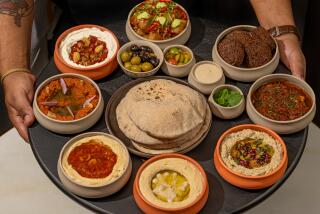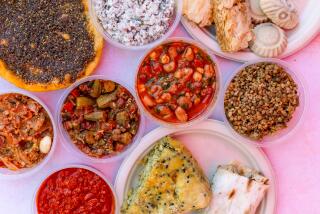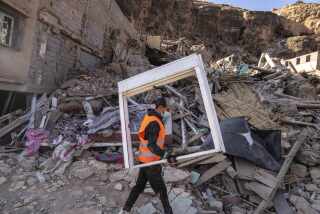Marrakech’s new Euro chic
SOMEONE must have rubbed a brass lamp and let a genie out of a bottle. That’s the only conclusion I can draw, given the changes to Marrakech since my last visit a decade ago.
In those days, the low, burnt-umber-colored city on the Haouz Plain in southern Morocco had the ambiguous charms of a Muslim imperial capital and the hurly-burly of a caravansary. Nearly everything cried out to be photographed.
But the city was dirty and difficult to navigate, with few street signs in the maze-like medina, and it had only a handful of hotels and restaurants suitable for tourists. At night, the nonexistent sidewalks of Marrakech were rolled up.
When I returned a month ago, I found the eight gates of the walled city, built in 1070, flung open wide.
With a burgeoning population of about a million, Marrakech is cleaner and more tourist-friendly. On my previous visit, I was surrounded by annoying would-be guides and touts whenever I stepped outdoors. For the most part, that’s no longer the case.
An influx of Northern European snowbirds has slowed the retreat of the moneyed classes from the medina to the suburbs.
Many of the newcomers are architects and designers who have restored old townhouses as restaurants and guesthouses, helping to make Marrakech the coolest, chicest city in the Maghreb.
A European influence
THE Europeans brought their sense of style with them so that, these days, almost everywhere you turn in Marrakech you see something new: traditional djellaba robes and babouche slippers in fun, new fabrics; European-inspired gourmet twists on recipes for such old Moroccan standards as tajine, a ubiquitous stew; and a host of trendy new boutique hotels.Best of all, people have rediscovered the elegant architecture of the hermitic medina, which blends austere Islamic abstraction with Moorish embellishment, sub-Saharan design and the colorful folk art of the Berber people of the Atlas Mountains.
The genie behind the city’s transformation was King Mohammed VI, who took the throne of the democratic monarchy of Morocco in 1999. Two years later, he launched an initiative to ready the country to receive 10 million tourists by 2010.
The program has encouraged foreign investment, especially in hotels, and new airlines, such as budget carrier Atlas Blue, to reach new Moroccan destinations such as Agadir, an Atlantic port in southwestern Morocco.
It has trained tourism workers and has taught average, workaday Moroccans how to make visitors welcome, without the old harassment and hard-sell.
Hucksters in the Place Jamaa el-Fna are more circumspect, partly because of the presence of plainclothes police, and kids in the alleyways know they shouldn’t pester tourists, even if their unquenchable desire for spare coins sometimes gets the better of them.
Of course, the city’s transformation doesn’t come without rubs. Many of Marrakech’s repeat visitors rue spiraling prices for meals and accommodations.
Hot, new nightclubs, catering to the beautiful international set, have arrived, such as Le Comptoir Darna, an ersatz Garden of Eden with such un-Moroccan features as belly-dancing and martinis.
Chockablock condominiums and Wal-Mart-style discount stores are turning the suburbs into a greater Palm Springs.
Fortunately, the city’s remarkable, main tourist attractions remain the same, if not in somewhat better repair than when I last visited.
Main attractions
THEY start with the Koutoubia mosque, a Marrakechi landmark, surrounded by sunstruck rose gardens and distinguished by a 230-foot, pink sandstone tower, the prototype of landmark minarets in Seville, Spain, and in Rabat, Morocco’s capital.Nearby is the Place Jamaa el-Fna, the heart of the medina and the liveliest, most un-reconstituted UNESCO World Heritage Site I’ve ever seen.
It yields to the city’s incomparably seductive souks. Even on my last visit, no amount of self-discipline could keep me away. This time, I bought two Berber carpets and as many pairs of babouche slippers as it would take to shoe a caterpillar.
There are still no reliable tourist maps of the inner medina, which is the main reason that roaming there is fun.
If you can find your way north of the Place Jamaa el-Fna to the Ben Youssef Medersa, you can inspect one of the Muslim world’s great educational centers.
Nearby is the recently restored, domed Qubba, a medieval water station, and the Museum of Marrakech, which puts contemporary art in the frame of a late 19th century Moroccan palace.
South of the Place Jamaa el-Fna, there are palaces, gardens, decorated gates and museums, such as Dar Si Said, dedicated to the arts and folk crafts of Morocco.
On twisting alleyways nearby is Dar Tiskiwin, an elegant townhouse, open to the public as a museum and full of Moroccan and sub-Saharan wonders collected by Bert Flint, a Dutch expatriate with a tall, lean frame and a shock of white hair.
As I left, he reminded me that historians study Morocco politically, as a western outpost of Dar al-Islam, even though it is geographically part of Africa.
To me, magnetic Marrakech will always be a little bit of everything: rough edges, deals to be made, djellabas and babouches, bright colors, energy, heat. I like the transformations that have come to it, but I hope the more it changes, the more it will stay the same.
*
(BEGIN TEXT OF INFOBOX)
Getting the most out of Morocco
GETTING THERE
From LAX, connecting service (change of plane) to Marrakech is available on Air France, Air New Zealand, American, British, United and Virgin Atlantic. Restricted round-trip fares begin at $894.
TELEPHONES:
To call
the numbers below from the U.S., dial 011 (the international dialing code), 212 (country code for Morocco), 44 (the city code for Marrakech) and the local number.WHERE TO STAY:
Dar Zouar, 14 Derb Mahrouk, 38-22-85, https://www.darzouar.com , is a modest riad in the north part of the medina, near the tomb of Sidi Bel Abbes es Sebti, one of the city’s seven venerated saints. It has five charmingly decorated and immaculately kept rooms, with private baths, priced, owner Thierry Dugast said, for students and professors, from $58 to $70, including breakfast.
Riad al Moussika, 62 Derb Boutouil, 38-90-67, https://www.riyad-al-moussika.com , is in a handsome, mid-19th century townhouse near the Museum Dar Si Said, a 10-minute walk south of the Place Jamaa el-Fna. It has a tiled swimming pool, two handsome courtyards, a hammam and six chambers, including a single and three suites. Rates $185-$410, including high-speed DSL, transfers, breakfast and lunch.
Riad Azzar, 94 Derb Moulay Abdelkader, 61-15-81-79 (do not dial 44 before this number), https://www.riadazzar.com , in the central medina’s Dabachi district, has been stylishly restored and decorated by Marique and Cees van den Berg, a Dutch couple, using treasures from their many trips to sub-Saharan Africa. It has a splash pool in the courtyard shaded by a banana tree, awning-covered roof terrace and winding staircases leading to six rooms; $120-$390, including breakfast.
Riad Farnatchi, 2 Derb el Farnatchi, 38-49-10, https://www.riadfarnatchi.com , is an elegant hideaway owned by an English hotelier, with an especially attentive staff. Guests are given djellaba robes and babouche slippers on arrival for lounging in curtained salons that look like stage sets surrounding two paradisiacal courtyards, one with a splash pool. Its six suites feature marble baths and custom-made beds and are priced at $370-$550, including breakfast, airport transfers, use of the hammam and non-alcoholic beverages and snacks.
Riad Malika, 29 Arset Aouzal, 38-54-51, https://www.riadmalika.com , near the Bab Doukkala Mosque, was one of the first guesthouses to open in the medina. Its funky-chic décor is part Moroccan, part 1960s retro, with bubble lamps and Naugahyde chairs. There are two courtyards, one with a small pool and hammam, and 11 chambers, priced at $120-$175, including breakfast and lunch or dinner.
Marrakech Riads, 8 Derb Cherfa Lakbir, 42-64-63 or 39-16-09, https://www.marrakech-riads.com , is a collection of five medina guesthouses owned by a Moroccan who specializes in restoring traditional townhouses in the medina. Doubles are $70-$110, including breakfast.
Hotels & Ryads, 20 Passage de la Bonne Graine, Paris, 011-33-1-42-08-18-33, https://www.riadsmorocco.com , is a booking agency with a comprehensive website and English-speaking staff that handles 60 guesthouses and hotels in Marrakech, Essaouira and Fès. Rates about $50-$350 a night.
WHERE TO EAT:
Dar Moha, 81 Dar el Bacha, 38-64-00, set in a garden around a pool, and Dar Zellij, 1 Kaasour Sidi Ben Slimane, 38-26-27, in a fastidiously renovated 17th century mansion with carved cedar ceilings and hand-cut zellij tile, specialize in fine, traditional Moroccan fare. Multi-course dinners run $40-$45, and both restaurants have wine lists.
Casa Lalla, Rue Riad Zitoune Lakdime, 16 Derb Jamaa, 42-97-57, offers a set-price menu created by Michelin-starred British chef Richard Neat. There is one sitting at 8 p.m., and only 14 people are served each night, so the required reservations are hard to come by. The price per person is about $40, and diners may bring in their own wine.
Le Pavillon, 47 Derb Zaouia, 38-70-40, and Le Foundouk, 55 El Moukef Souk Hal Fassi Kat Bennahid, 37-81-90, serve French food and wine. Both are in the heart of the medina. Dinner about $40.
Bo-Zin, Route d l’Ourika, 38-80-12, is a 15-minute drive south of town, with a beautiful cactus garden for alfresco dining. The cuisine is chiefly Thai and there is a full bar. The price for a three-course dinner is $40-$50, not including drinks.
TO LEARN MORE:
Moroccan National Office of Tourism, (407) 264-0133, https://www.tourisme-marocain.com .
— Susan Spano
More to Read
Sign up for The Wild
We’ll help you find the best places to hike, bike and run, as well as the perfect silent spots for meditation and yoga.
You may occasionally receive promotional content from the Los Angeles Times.






